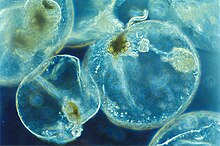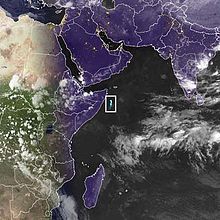Sea lights
As Meeresleuchten light phenomena are referred to sea, the bioluminescence are attributed. Sea lights can be observed both on the coast and in the open sea.
Biology of marine glow
The classic sea glow is generated by the accumulation of microorganisms and is therefore part of the phenomenon of bioluminescence . The organisms that can trigger sea glow include dinoflagellates such as Noctiluca scintillans , Pyrocystis fusiformis and Pyrocystis noctiluca , which are also involved in the so-called red tides . Dinoflagellates are unicellular organisms that are counted among the algae .
When the sea shines, the sea water seems to luminesce blue to green. In fact, it is not the sea water itself that shines, but the microorganisms in the sea water send out more or less long-lasting light signals after being touched.
You can see that the glow is triggered by touch stimuli on the beach. If you can see the glow of the sea in the surf, you can bring it about in the sand of the beach by running your hands or feet over the sand. The organisms that are touched become visible as small, luminous points. Sea lights are only found occasionally, because the necessary microorganisms do not always occur in the required concentration in sea water. The exact framework conditions for the occurrence of the microorganisms have not yet been fully clarified.
The working group around the American biologist Michael Latz at the Californian marine research institute Scripps Institution of Oceanography is developing methods to use the bioluminescence of marine luminescence for flow research, e.g. B. for the development of low-turbulence ship hulls.
"Artificial sea lights" based on the principle of chemiluminescence can be generated using luminol .
Christian Gottfried Ehrenberg already referred to production by microorganisms in 1835.
Reports from the 17th and 18th centuries
Sea lights appear twice a year around the Banda Islands , which was described in detail as the Mare album by Georg Eberhard Rumpf . He must have observed this phenomenon in the Moluccas before 1670 . Rumpf could no longer examine the phenomenon himself because he became blind from 1670 and did not have a microscope.
Ernst Christoph Barchewitz from Erfurt had observed a similar phenomenon on the Bandasee when he was on Leti .
Sea lights in fantastic literature
The glow of the sea appeared again and again in historical accounts by seafarers and then in fiction, for example in Jules Verne's Twenty Thousand Leagues Under the Sea .
In the children's book Jim Knopf und die Wilde 13 by Michael Ende (published 1962), the sea lights play a key role: Jim Knopf has to help repair the sea lights in order to illuminate the realm of mermaids and mermen. In Ende's book, however, the sea glow is created by switching on the large Gurumusch magnet .
Web links
- Martin Winkelheide : A satellite spies the milky glow of the sea , Deutschlandfunk - Forschungs aktuell dated September 27, 2005, accessed on January 10, 2012.
- Researchers solve puzzles about mysterious sea lights
Individual evidence
- ↑ a b Sea lights - incredibly beautiful. In: State Office for Coastal Protection, National Park and Marine Protection Schleswig-Holstein, nationalpark-wattenmeer.de. August 1, 2007, accessed October 18, 2019 .
- ↑ a b bioluminescence. In: Andrea Wengel, Westdeutscher Rundfunk Köln, planet-wissen.de. July 24, 2019, accessed October 18, 2019 .
- ^ Georg Everhardus Rumphius. Amboinsche Rariteit-Kamer 1705, pp. 247-251
- ↑ W. Buijze: Leven en werk van Georg Everhard Rumphius (1627-1702). In: Een natuurhistoricus in dienst van de VOC. The Hague 2006, p. 120
- ^ Ernst Christoph Barchewitz. East Indian travel description, Erfurt 1751, p. 428


